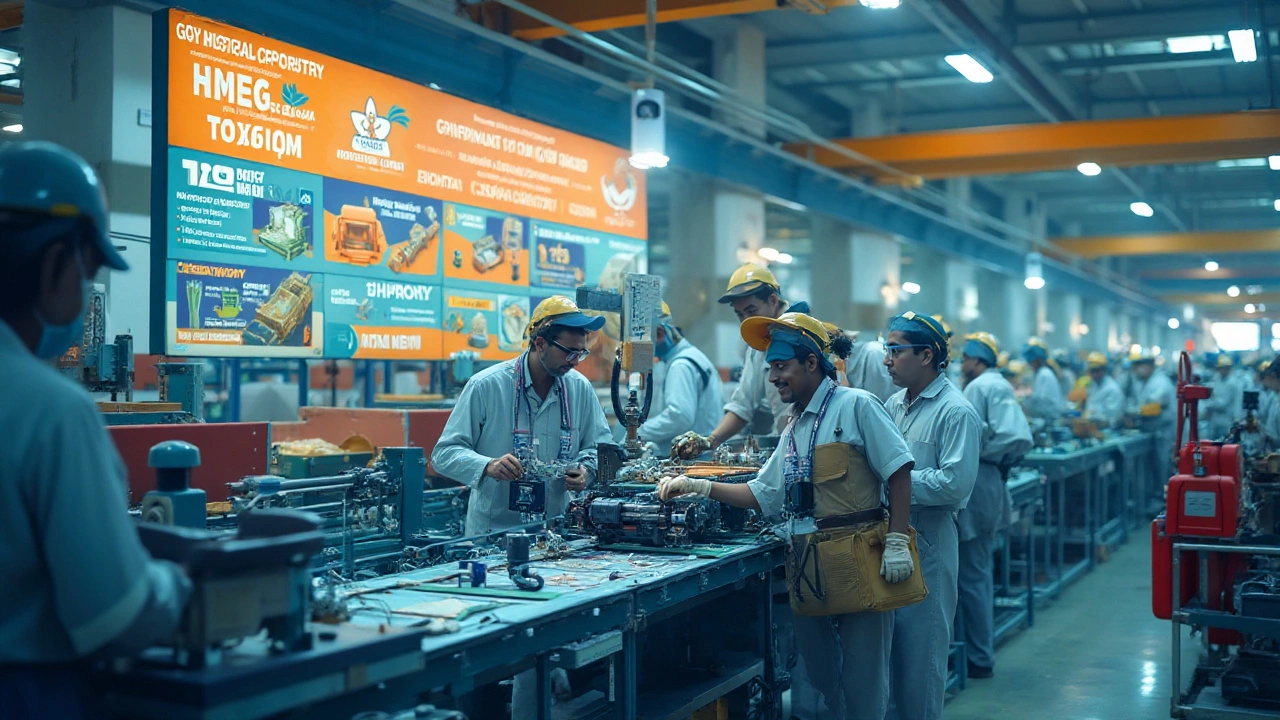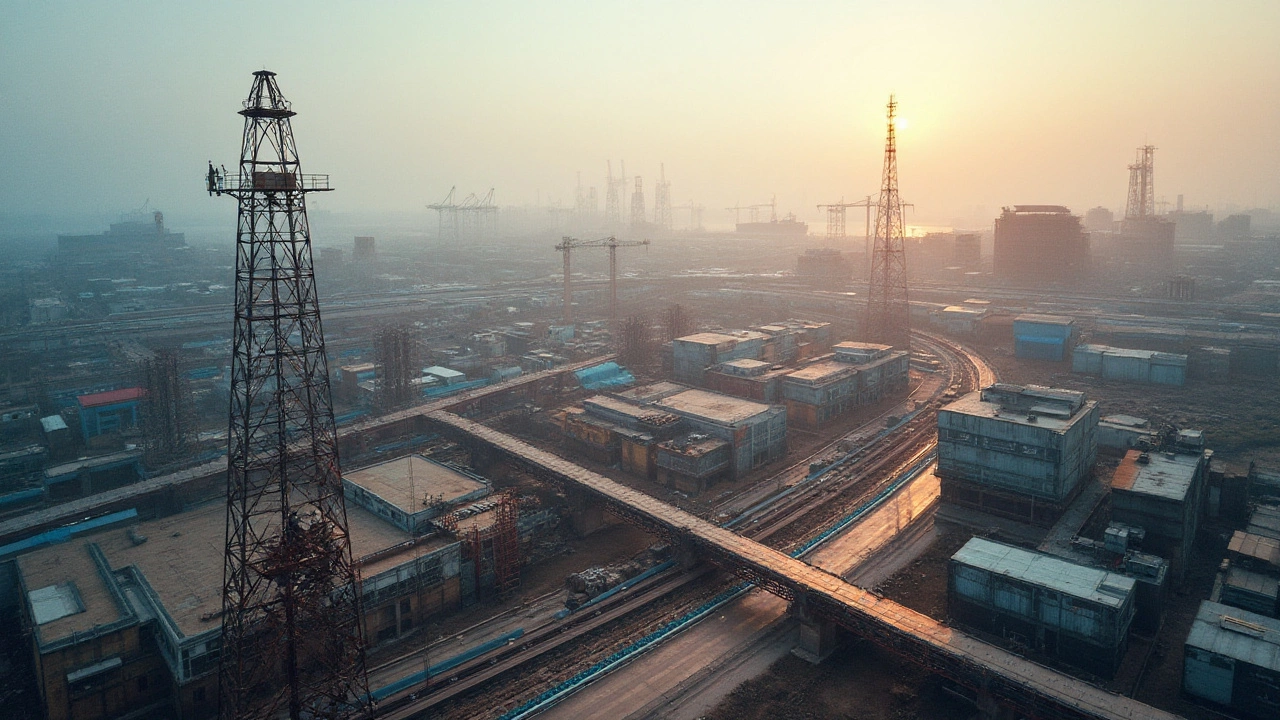 Jan, 13 2025
Jan, 13 2025
Manufacturing stands as one of the fundamental pillars supporting a country's economic framework. Its influence extends beyond mere production lines, affecting almost every facet of national prosperity. From providing employment to generating revenue and fostering innovation, the manufacturing sector has starry-eyed potential to transform economies.
But how does this process unfold within the realm of public policy and government support? This question takes center stage as we delve into the multiple ways manufacturing acts as a catalyst for national growth. By exploring the intricate relationship between government schemes and industrial capability, we unveil the vital role manufacturing continues to play in shaping the economic landscape.
- Economic Foundation of Manufacturing
- Job Creation and Workforce Development
- Technological Innovation and Investment
- Government Initiatives and Support
- Global Trade and Export Potential
Economic Foundation of Manufacturing
Manufacturing is the backbone of many economies, driving the wheels of progress and development. It acts as a crucial component that significantly contributes to the gross domestic product (GDP) of a nation. Through this lens, one can observe how manufacturing not only produces goods but also generates income and tax revenue, creating a ripple effect across the economic spectrum. This sector is pivotal for a country aiming to elevate its standards in wealth and livelihood, as it stimulates economic activity both directly and indirectly. The interconnectedness of manufacturing with other sectors like services and agriculture cannot be overstated, marking its influence across different strata of society.
The evolution of manufacturing industries often marks transitions in economic phases, from agrarian-based economies to industrialized powerhouses. Nations like Germany and Japan have shown how a strong manufacturing sector can transform the economic fabric of a country, turning them into global hubs of innovation and efficiency. The transformation isn't limited to advances in industrial processes but extends into skill development and educational growth that accompany this industrial boom. Workers transition from unskilled labor to acquiring specialized knowledge, hence bringing about a substantial improvement in their quality of life.
"Manufacturing is more than just putting parts together. It's coming up with ideas, testing principles, and perfecting the engineering as well as final assembly." – James Dyson
The Role of Infrastructure
In tandem with industrial growth, infrastructure development becomes a focal point. Roads, ports, and power supplies not only support the manufacturing sector but also propel overall economic enhancement. Investment in logistics and supply chain networks is vital for ensuring the distribution of manufactured goods. Consider how the creation of industrial corridors and special economic zones create an environment conducive to sustained industrial development. Governments that prioritize infrastructure enjoy the fruits of a competitive manufacturing sector, which in turn attracts foreign investment and technology transfer, thus setting off a virtuous cycle of economic prosperity.
The Workforce and Employment
Employment generation remains one of the most significant benefits brought about by the rise of manufacturing. Factories open doors to millions of jobs ranging from assembly line workers to highly skilled technicians and engineers. These employment opportunities drive wage growth and contribute to reducing poverty levels systematically. The sector's unique capacity to bring about broad-based employment often makes it a central point of government policy initiatives aimed at reducing joblessness. Targeted programs that educate and train the workforce go a long way in increasing productivity, which in turn can strengthen a nation’s foothold in competitive global markets.
Job Creation and Workforce Development
The manufacturing sector plays an indispensable role in invigorating job markets across nations. By opening up new employment opportunities, manufacturing not only aids in reducing unemployment rates but also creates specialized avenues for development. Jobs within this sector are unique; they include positions that range from skilled labor and engineering roles to research and administrative work. This diversity enriches the workforce, enabling a more versatile economic landscape. A notable example of this is Germany's robust manufacturing industry, which has been a career cornerstone for millions, contributing significantly to the country’s low unemployment rate.
Many countries invest in vocational training and apprenticeships to further bridge the skills gap. These initiatives are crucial for adapting the workforce to meet the evolving demands of modern manufacturing technologies. Countries like China have established thousands of vocational schools dedicated solely to training future factory workers and technicians. Such educational paradigms are a testament to how focused investment in workforce development can yield rapid industrial progress. As the machinery and technology in manufacturing advance, so does the requirement for highly trained professionals to manage these sophisticated systems, creating a snowball effect of growth and advancement.
Manufacturing also brings with it the challenge of ensuring worker welfare and equitable distribution of labor benefits. In an industry known for both its opportunities and its risks, workforce development programs must emphasize safety as much as skill enhancement. For instance, Japan has instituted multiple safety regulations to ensure that its burgeoning manufacturing sector doesn’t jeopardize worker health. As mentioned by the International Labour Organization, “Manufacturing offers great potential for employment generation but ensuring job quality is vital.”
"Manufacturing offers great potential for employment generation but ensuring job quality is vital." — International Labour Organization
The ripples made by manufacturing extend beyond direct employment, spilling over to support roles and peripheral industries. As manufacturing plants thrive, businesses such as logistics, retail, and maintenance services naturally flourish around them. This interconnectedness lays the groundwork for multifaceted economic growth. Consider how the automotive manufacturing industry has spurred developments in raw materials, parts distribution, and after-market services globally. To illustrate this further, empirical data shows that for every manufacturing job created, approximately 1.4 jobs are indirectly generated in related sectors. These numbers highlight the multiplier effect that manufacturing has, reinforcing its importance as a linchpin in job creation.

Technological Innovation and Investment
The manufacturing sector is not just the backbone of physical production; it’s a thriving hub for technological innovation and significant investment. Over the years, we’ve seen how technology shapes the industry, constantly evolving to meet the demands of a competitive market. The introduction of automation and smart manufacturing processes has revolutionized the way products are made, improving efficiency and reducing waste. Many countries have embraced Industry 4.0, which integrates advanced technologies like the Internet of Things (IoT), artificial intelligence (AI), and robotics into their manufacturing processes. This industrial revolution has turned manufacturing units into high-tech operations centers, leading to increased productivity and quality.
Investing in technology not only benefits manufacturers but also positions countries competitively on the global stage. Nations that prioritize innovation are often seen as leaders in economic growth and development. Germany, for instance, has been recognized for its dedication to advanced manufacturing, significantly contributing to its status as an economic powerhouse. Investments in research and development (R&D) enable companies to pursue new technologies that can provide a competitive edge. According to a report by the World Economic Forum, European firms have been leading in R&D investment, focusing on green technologies to achieve sustainable manufacturing.
With the constant drive towards innovation, many governments implement policies that encourage R&D investment. Tax incentives and grants are often used to support startups and established companies alike, providing them with the necessary resources to explore new frontiers. In the UK, the government has initiated the 'Made Smarter' review, which proposes plans to increase industrial productivity by integrating digital technologies. Such initiatives highlight the importance of maintaining a supportive environment where technological advancement can flourish.
"Innovation distinguishes between a leader and a follower," said Steve Jobs, emphasizing the significance of technological progress in securing a competitive edge.
Moreover, the synergy between the public sector and private industries is crucial for fostering a culture of innovation. Collaborative efforts in creating tech hubs and incubators serve to bridge gaps, providing platforms for sharing knowledge and resources. An example of successful collaboration is the manufacturing institutes under the US National Network for Manufacturing Innovation (NNMI). These institutes focus on areas like smart manufacturing and sustainable production methods, ensuring that the US remains at the forefront of technological advancements in manufacturing.
Technology and investment in manufacturing don't just serve the industry; they have broader economic implications. With advancements in manufacturing processes, there is an increase in the capability for economic growth and job creation, particularly in technology-driven roles. These positions require new skill sets, spurring efforts to enhance workforce training and education. By prioritizing technology and investment, countries can ensure sustainable economic progress and safeguard their competitive standing globally.
Government Initiatives and Support
In many countries, the manufacturing sector acts as an engine of growth, supported by a plethora of government schemes designed to boost productivity, create jobs, and attract investment. These initiatives are rooted in the understanding that a strong manufacturing base is vital for national economic stability and prosperity. Let's explore the tools and strategies that governments deploy to facilitate growth in this critically important sector.
Firstly, tax incentives have long been a favorite tool in the governmental toolbox to promote economic growth. By offering reduced tax rates or tax holidays, governments aim to create a favorable business climate that encourages both local and foreign companies to invest in manufacturing facilities. This kind of financial relief can significantly lower operational costs, enabling companies to expand their operations, hire more workers, and reinvest in technology and infrastructure.
Investment in infrastructure is another critical area where government support can make a substantial difference. Well-developed transport networks, reliable energy supplies, and high-speed internet are all fundamental to the growth of the manufacturing sector. By investing in these areas, governments not only improve the efficiency with which goods move to market but also create an attractive environment for both domestic and international investors.
Research and development (R&D) grants are also pivotal. By providing financial backing for innovation, governments can drive technological advances that improve manufacturing efficiency and product quality. This financial support is often augmented by partnerships with universities and research institutions, as well as tax credits aimed directly at companies investing in new technologies.
One cannot overlook the significance of skills training programs coordinated by governments. A skilled workforce is essential for operating complex manufacturing technologies and ensuring high productivity. By funding technical education and vocational training programs, governments help create a pool of qualified workers ready to meet the needs of advanced manufacturing settings. This symbiotic relationship between education and industry not only enhances employment rates but also meets productivity targets.
Global trade agreements also fall under the purview of government initiatives aimed at enhancing manufacturing. By negotiating favorable trade terms, governments can help local manufacturers gain access to international markets. This access not only increases export potential but also enables companies to achieve economies of scale, ultimately lowering per-unit costs of goods manufactured.
"The governments who understand the art of manufacturing, nurture their economies as garden enlargers grow plants. They plant initiatives and watch as industries blossom," noted a manufacturing expert during a global summit.
By actively engaging with these diverse strategies, governments are able to lay the groundwork for a resilient manufacturing sector, which in turn contributes to the nation's economic growth. These initiatives are not just about immediate economic gains; they are investments in the country's future, ensuring long-term stability and prosperity.

Global Trade and Export Potential
Manufacturing is the engine that drives global trade, playing a crucial role in how countries interact with the international market. By producing goods that appeal not only to local but also international consumers, a nation can secure its place as a pivotal player on the global stage. This ability to engage in trade has significant implications. The export of manufactured goods can help bridge trade deficits, leading to a more balanced economic buoyancy. According to the World Bank, every 1% increase in industrial production growth can lead to a 0.65% increase in export activity. This statistic underscores the importance of a robust manufacturing sector to a nation's trade prospects.
Nations that identify niche markets and cater to specific demands often find themselves reaping significant rewards. For instance, Germany has carved out a niche in high-quality automobiles and machinery, making these products highly sought after worldwide. This is no accident but rather the result of deliberate government policies and private sector innovation. These countries not only boost their revenue by increasing exports but also enhance their global influence. The ability to export also means increased foreign direct investment, as international firms are often keen to invest in markets with strong export capabilities and infrastructure.
"The future belongs to nations with the strongest export-led industrial base," said economist Paul Krugman. "Manufacturing offers not just the advantage of economic returns but also the strategic benefits of increased political and economic influence on the global stage."
Let us not forget that engaging in global trade tramite manufacturing is a two-way street. Countries are often required to meet stringent international standards, improving their product quality across the board. This demand for high-quality output can advance national manufacturing processes and technologies, indirectly benefitting domestic consumers as well. As they upgrade their methods to meet global standards, their reputation grows, making it easier to break into new markets. On top of that, sustained engagements in trade allow for improved diplomatic ties, often translating into stronger strategic alliances.
A glance at the past few decades reveals how the Asian Tigers, like South Korea and Taiwan, developed their economies partly through a strategic focus on manufacturing exports. South Korea's dedication to strengthening its technological sector led to the birth of global icons like Samsung and Hyundai, giants that are synonymous with quality across continents. This has not only brought significant profits but has solidified South Korea as a formidable force in global trade. It’s no surprise that these success stories become case studies for other developing countries, offering a blueprint for economic growth through manufacturing and export.
In conclusion, investing in manufacturing isn't just about boosting local economies. It opens doors to an interconnected global marketplace, filled with numerous opportunities for revenue and growth. With the right approach, international trade can serve as a mighty lever for national economic development. It's evident that nations committed to tapping into their full manufacturing potential today will find themselves leading the pack in tomorrow’s global economy.